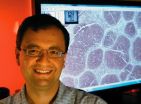Hunt for dark matter closes in at Large Hadron Collider
2011-02-01
(Press-News.org) The scientists have now carried out the first full run of experiments that smash protons together at almost the speed of light. When these sub-atomic particles collide at the heart of the CMS detector, the resultant energies and densities are similar to those that were present in the first instants of the Universe, immediately after the Big Bang some 13.7 billion years ago. The unique conditions created by these collisions can lead to the production of new particles that would have existed in those early instants and have since disappeared.
The researchers say they are well on their way to being able to either confirm or rule out one of the primary theories that could solve many of the outstanding questions of particle physics, known as Supersymmetry (SUSY). Many hope it could be a valid extension for the Standard Model of particle physics, which describes the interactions of known subatomic particles with astonishing precision but fails to incorporate general relativity, dark matter and dark energy.
Dark matter is an invisible substance that we cannot detect directly but whose presence is inferred from the rotation of galaxies. Physicists believe that it makes up about a quarter of the mass of the Universe whilst the ordinary and visible matter only makes up about 5% of the mass of the Universe. Its composition is a mystery, leading to intriguing possibilities of hitherto undiscovered physics.
Professor Geoff Hall from the Department of Physics at Imperial College London, who works on the CMS experiment, said: "We have made an important step forward in the hunt for dark matter, although no discovery has yet been made. These results have come faster than we expected because the LHC and CMS ran better last year than we dared hope and we are now very optimistic about the prospects of pinning down Supersymmetry in the next few years."
The energy released in proton-proton collisions in CMS manifests itself as particles that fly away in all directions. Most collisions produce known particles but, on rare occasions, new ones may be produced, including those predicted by SUSY – known as supersymmetric particles, or 'sparticles'. The lightest sparticle is a natural candidate for dark matter as it is stable and CMS would only 'see' these objects through an absence of their signal in the detector, leading to an imbalance of energy and momentum.
In order to search for sparticles, CMS looks for collisions that produce two or more high-energy 'jets' (bunches of particles travelling in approximately the same direction) and significant missing energy.
Dr Oliver Buchmueller, also from the Department of Physics at Imperial College London, but who is based at CERN, explained: "We need a good understanding of the ordinary collisions so that we can recognise the unusual ones when they happen. Such collisions are rare but can be produced by known physics. We examined some 3 trillion proton-proton collisions and found 13 'SUSY-like' ones, around the number that we expected. Although no evidence for sparticles was found, this measurement narrows down the area for the search for dark matter significantly."
The physicists are now looking forward to the 2011 run of the LHC and CMS, which is expected to bring in data that could confirm Supersymmetry as an explanation for dark matter.
The CMS experiment is one of two general purpose experiments designed to collect data from the LHC, along with ATLAS (A Toroidal LHC ApparatuS). Imperial's High Energy Physics Group has played a major role in the design and construction of CMS and now many of the members are working on the mission to find new particles, including the elusive Higgs boson particle (if it exists), and solve some of the mysteries of nature, such as where mass comes from, why there is no anti-matter in our Universe and whether there are more than three spatial dimensions.
INFORMATION: END
ELSE PRESS RELEASES FROM THIS DATE:
2011-02-01
New Haven, Conn.—A team of Yale University scientists has synthesized for the first time a chemical compound called lomaiviticin aglycon, leading to the development of a new class of molecules that appear to target and destroy cancer stem cells.
Chemists worldwide have been interested in lomaiviticin's potential anticancer properties since its discovery in 2001. But so far, they have been unable to obtain significant quantities of the compound, which is produced by a rare marine bacterium that cannot be easily coaxed into creating the molecule. For the past decade, different ...
2011-02-01
Researchers at National Jewish Health have discovered a signaling pathway that is crucial to the devastating effects of acute lung injury (ALI). The data, obtained from cells, animals and ALI patients, suggest several potential therapeutic targets. Experimental blockade of one of the targets significantly reduced flooding of the lungs that is the hallmark of ALI.
"Acute lung injury is a devastating disease, with 40 percent mortality and no beneficial therapies," said first author James Finigan, MD, Assistant Professor of Medicine at National Jewish Health. "Our study ...
2011-02-01
It takes songbirds and baseball pitchers thousands of repetitions – a choreography of many muscle movements -- to develop an irresistible trill or a killer slider. Now, scientists have discovered that the male Bengalese finch uses a simple mental computation and an uncanny memory to create its near-perfect mate-catching melody -- a finding that could have implications for rehabilitating people with neuromuscular diseases and injuries.
Young male Bengalese finches practice their boisterous mating song hundreds of times a day, comparing their melody to the songs of their ...
2011-02-01
Researchers have found that a novel form of personalized therapy that genetically engineers a patient's own anti-tumor immune cells to fight tumors could treat metastatic melanoma and metastatic synovial cell sarcoma, representing a potentially new therapeutic approach against these and other cancers.
The technique, called adoptive immunotherapy, works with the body's immune system to fight cancer. Immune cells, called T lymphocytes, are removed, modified, expanded in large numbers, and given back to the patient. In this case, the process entailed genetically engineering ...
2011-02-01
Researchers are leveraging Ohio Supercomputer Center resources to develop computer-assisted diagnosis tools that will provide pathologists grading Follicular Lymphoma samples with quicker, more consistently accurate diagnoses.
"The advent of digital whole-slide scanners in recent years has spurred a revolution in imaging technology for histopathology," according to Metin N. Gurcan, Ph.D., an associate professor of Biomedical Informatics at The Ohio State University Medical Center. "The large multi-gigapixel images produced by these scanners contain a wealth of information ...
2011-02-01
Drug- and explosives-sniffing dog/handler teams' performance is affected by human handlers' beliefs, possibly in response to subtle, unintentional handler cues, a study by researchers at UC Davis has found.
The study, published in the January issue of the journal Animal Cognition, found that detection-dog/handler teams erroneously "alerted," or identified a scent, when there was no scent present more than 200 times — particularly when the handler believed that there was scent present.
"It isn't just about how sensitive a dog's nose is or how well-trained a dog is. There ...
2011-02-01
Tropical Storm Anthony made landfall in Queensland, Australia this past weekend, and now the residents are watching a larger, more powerful cyclone headed their way. NASA's Terra satellite captured a visible image of the large Tropical Cyclone Yasi late yesterday as it makes its way west through the Coral Sea toward Queensland.
The Moderate Resolution Imaging Spectroradiometer (MODIS) instrument that flies aboard NASA's Terra satellite captured an image of Cyclone Yasi on Jan. 30 at 23:20 UTC (6:20 p.m. EST/09:20 a.m., Monday, January 31 in Australia/Brisbane local time). ...
2011-02-01
NASA's Time History of Events and Macroscale Interaction during Substorms (THEMIS) spacecraft combined with computer models have helped track the origin of the energetic particles in Earth's magnetic atmosphere that appear during a kind of space weather called a substorm. Understanding the source of such particles and how they are shuttled through Earth's atmosphere is crucial to better understanding the Sun's complex space weather system and thus protect satellites or even humans in space.
The results show that these speedy electrons gain extra energy from changing magnetic ...
2011-02-01
(Santa Barbara, Calif.) –– Inspired by the popular confidence trick known as "shell game," researchers at UC Santa Barbara have demonstrated the ability to hide and shuffle "quantum-mechanical peas" –– microwave single photons –– under and between three microwave resonators, or "quantized shells."
In a paper published in the Jan. 30 issue of the journal Nature Physics, UCSB researchers show the first demonstration of the coherent control of a multi-resonator architecture. This topic has been a holy grail among physicists studying photons at the quantum-mechanical level ...
2011-02-01
Children from poorer families do worse in school, are less likely to graduate from high school, and are less likely to go to college. A new study published in Psychological Science, a journal of the Association for Psychological Science, finds that these differences appear surprisingly early: by the age of 2. It's not a genetic difference. Instead, something about the poorer children's environment is keeping them from realizing their genetic potentials.
Past research has found that a gap between poor children and children from wealthier families opens up early in life, ...
LAST 30 PRESS RELEASES:
[Press-News.org] Hunt for dark matter closes in at Large Hadron Collider


